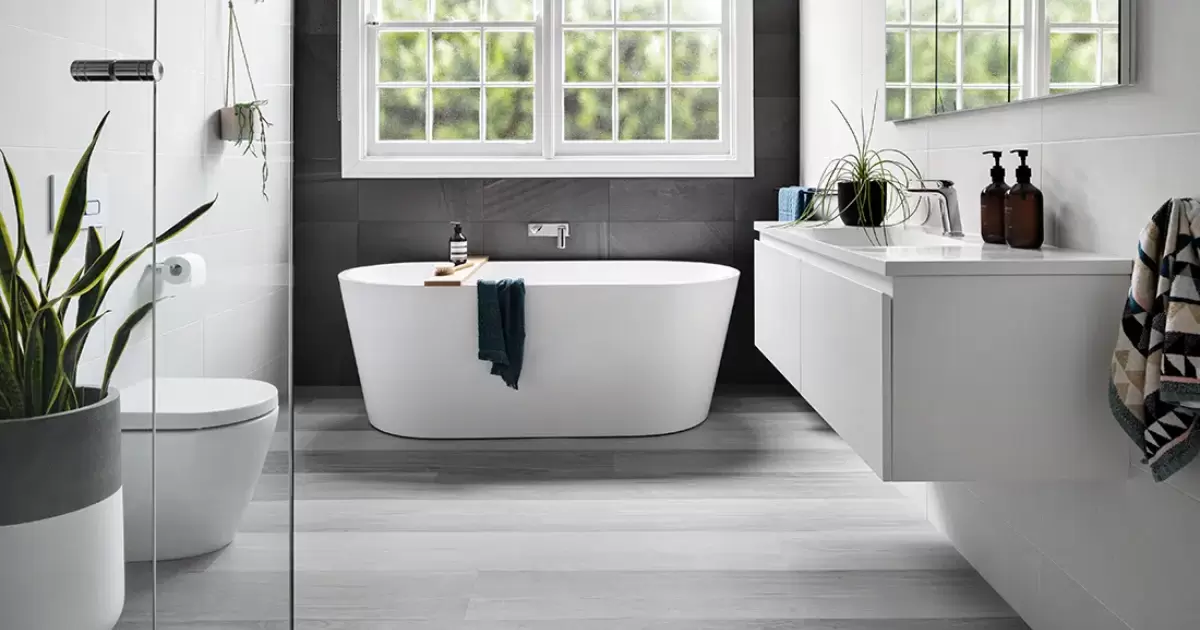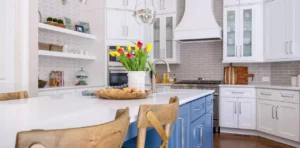The process of installing vinyl plank flooring in your bathroom will discover a straightforward and rewarding project that enhances both functionality and aesthetics. First, acclimate your vinyl planks for at least 24 to 48 hours to ensure they adjust to your bathroom’s environment.
This step helps prevent issues like buckling or gaps during installation ensuring a smooth and durable result.Next, prepare your bathroom’s subfloor by ensuring it is clean dry and level. This essential step creates a stable foundation for your vinyl planks promoting longevity and minimizing the risk of future problems.
Adding a layer of underlayment further enhances performance especially over concrete providing extra cushioning and moisture protection for your new flooring.
Bathroom
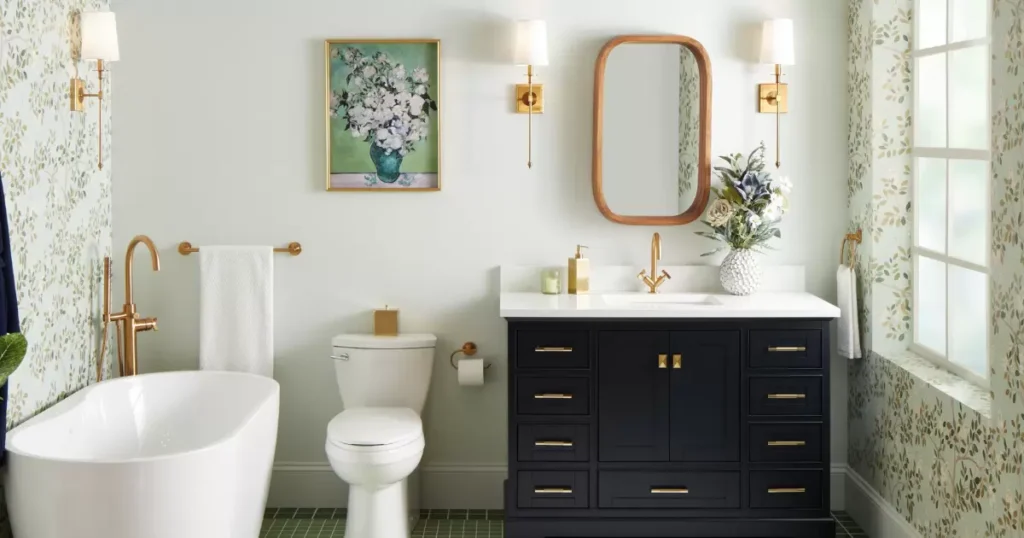
The bathroom is a vital space in any home serving as a place for relaxation rejuvenation and daily routines. It is where we start and end our days making it essential to create a comfortable and functional environment.
From morning showers to evening baths the flooring in your bathroom must withstand moisture and frequent use while still maintaining its beauty and durability. Choosing the right flooring material is crucial to ensure a pleasant and hassle-free experience in this essential room of the house.
Read more Blog: Kitchen Cabinet Materials For Your DIY Project
Tools Used
In the bathroom you will commonly find several tools and items that are essential for various tasks and maintenance. Here are some of them:
- Plunger: A plunger is indispensable for unclogging toilets and drains, helping to quickly resolve blockages and keep your plumbing flowing smoothly.
- Toilet Brush: This tool is used for cleaning the inside of the toilet bowl, removing stains, and maintaining hygiene.
- Caulking Gun: Caulking guns are handy for applying caulking around sinks, tubs, and showers to prevent water leaks and maintain a watertight seal.
- Adjustable Wrench: An adjustable wrench is useful for tightening or loosening nuts and bolts on plumbing fixtures like faucets and pipes.
- Tile Grout Scraper: Used for removing old or damaged grout between tiles, a grout scraper helps prepare surfaces for regrouting, ensuring a clean and polished look.
- Screwdriver Set: A set of screwdrivers both flathead and Phillips comes in handy for various tasks such as installing or repairing fixtures tightening screws on cabinets or assembling furniture in the bathroom.
Materials/Supplies
Certainly here are five materials/supplies commonly found in bathrooms:
- Tile
- Grout
- Caulk
- Towels
- Soap
Does your Bathroom Include a Shower or Bathtub?
These fixtures are essential components of any bathroom offering options for bathing and relaxation. You prefer a quick shower to start your day or a soothing soak in the tub after a long day. Having both options ensures your bathroom meets your needs and preferences.
A shower provides convenience and efficiency allowing for a speedy cleanse when time is of the essence. With various shower head options available you can customize your shower experience with features like adjustable water pressure and spray patterns enhancing comfort and enjoyment.
On the other hand a bathtub offers a luxurious retreat perfect for unwinding and indulging in a leisurely soak. You prefer a classic built-in tub or a freestanding clawfoot design. The bathtub provides a space for relaxation self care and rejuvenation in the comfort of your own home.
Is There a Way To Waterproof Vinyl Plank Flooring?
While vinyl plank flooring itself is inherently waterproof there are additional steps you can take to enhance its water resistance further. One option is to apply a sealant or topcoat specifically designed for vinyl flooring creating an additional barrier against moisture penetration.
Ensuring proper installation and maintenance can help prevent water damage. Properly sealing seams and edges during installation and promptly addressing any spills or leaks can help maintain the integrity of your vinyl plank flooring and prolong its lifespan
Existing Sheet Laminate Flooring
Existing sheet laminate flooring refers to a type of flooring that comes in large continuous sheets rather than individual planks or tiles. This flooring option is popular for its affordability durability and easy maintenance.
Over time existing sheet laminate flooring may show signs of wear and tear such as scratches stains or fading.If you have existing sheet laminate flooring and are considering upgrading to vinyl plank flooring you will first need to prepare the subfloor.
This may involve removing the old laminate flooring ensuring the subfloor is clean level and free of any debris or adhesive residue before proceeding with the installation of the new vinyl planks.
Existing Ceramic Tile Flooring
Existing ceramic tile flooring provides a durable and stylish option for many homeowners. With its resistance to moisture stains and scratches ceramic tile flooring is a popular choice for bathrooms kitchens and other high traffic areas.
If you are considering replacing it with vinyl plank flooring there are a few considerations to keep in mind.Before installing vinyl plank flooring over existing ceramic tile it is crucial to ensure that the tile surface is clean flat and free of any damage.
Depending on the condition of the tile and your preference you may need to use a primer or leveling compound to create a smooth and even surface for the vinyl planks. Some homeowners opt to install an underlayment before laying the vinyl planks to provide extra cushioning and insulation.
Will you Need to Lower Your Toilet Flange?
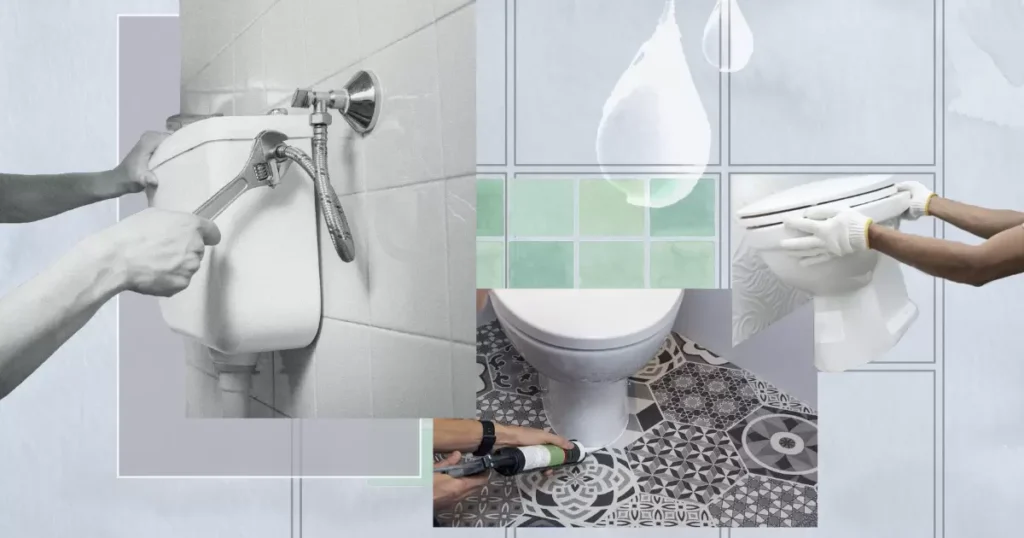
vinyl plank flooring typically adds height to the floor, the toilet flange may need to be adjusted to ensure a proper fit. Lowering the toilet flange involves removing the toilet adjusting the flange height and reinstalling the toilet on top of the new flooring.
Lowering the toilet flange may be necessary to ensure a secure and leak free connection between the toilet and the waste pipe. It is essential to follow manufacturer instructions and local plumbing codes when making adjustments to the toilet flange to ensure proper installation and functionality.
Removing Existing Flooring
Removing existing flooring is a necessary step when installing new vinyl plank flooring. This process typically involves several steps depending on the type of flooring being removed. For laminate or vinyl flooring you can often lift and peel away the existing material relatively easily though adhesive residue may require additional cleaning.
For ceramic tile or hardwood flooring removing the existing flooring may be more labor intensive and require tools such as a hammer chisel or floor scraper to break up and remove the old material. Regardless of the type of flooring being removed it is essential to prepare the subfloor properly before installing the new vinyl planks to ensure a smooth and durable result.
Remove Toilet
Removing the toilet is a crucial step before installing vinyl plank flooring in a bathroom. To remove the toilet, start by turning off the water supply valve located behind the toilet and flushing to empty the tank and bowl.
Next, disconnect the water supply line and loosen the bolts securing the toilet to the floor using a wrench.Once the bolts are removed carefully lift the toilet straight up and off the flange ensuring no water spills from the drain pipe.
Set the toilet aside on a towel or old blanket to prevent damage to the flooring or fixtures. With the toilet removed, you can proceed with preparing the subfloor and installing the new vinyl plank flooring
Remove Trim
Removing trim such as baseboards or quarter round is often necessary before installing new flooring like vinyl planks. Start by carefully prying the trim away from the wall using a pry bar or putty knife being cautious not to damage the walls or trim pieces.
Once the trim is loosened gently pull it away from the wall starting at one end and working your way along the length. Set the removed trim aside in a safe place as it may be reused after the new flooring is installed.
Removing trim allows for a clean and professional looking installation of the vinyl plank flooring ensuring a seamless transition between the floor and walls.
Remove Ceramic Tile Flooring
Removing ceramic tile flooring is a labor intensive task but necessary when preparing for new flooring installation like vinyl planks. Begin by using a hammer and chisel to break up the tiles starting at one corner and working your way across the floor.
Once the tiles are removed you may need to scrape away any remaining adhesive or mortar to ensure a smooth and level subfloor. It is essential to wear protective gear such as gloves and goggles during this process to prevent injury from flying debris.
Also read this: How To Refinish A Dining Room Table
Prep Subfloor
Preparing the subfloor is a crucial step before installing vinyl plank flooring. Start by ensuring the subfloor is clean dry and free from any debris or adhesive residue.
Next, check for any unevenness or imperfections and address them as needed using a leveling compound or sanding down high spots.
Finally consider adding an underlayment for additional cushioning and moisture protection before laying the vinyl planks.
Check the Floor For Level
To ensure a smooth and even installation of vinyl plank flooring it is essential to check the floor for levelness. Begin by placing a long level tool such as a spirit level across different areas of the floor.
Pay close attention to any areas where the level indicates unevenness or slopes.If you notice any discrepancies, you may need to use a leveling compound to fill in low spots or sand down high spots until the floor is level.
Taking the time to properly level the floor ensures a professional-looking finish and prevents issues like uneven seams or gaps in the vinyl planks.
Remove Mastic
Removing mastic, a type of adhesive commonly used to install flooring, is necessary when preparing for new vinyl plank flooring installation. Begin by softening the mastic using a commercial adhesive remover or a heat gun.
Once softened carefully scrape away the mastic using a putty knife or floor scraper taking care not to damage the subfloor.Repeat the process until all traces of mastic are removed ensuring a clean and smooth surface for the vinyl plank flooring.
Finally thoroughly clean the subfloor to remove any remaining residue before proceeding with the installation.
Fix Floor Seams and Check Nails
Before installing vinyl plank flooring it is essential to fix any floor seams and check for protruding nails or screws on the subfloor. Inspect the seams between floorboards or sheets of plywood ensuring they are flush and free of gaps or raised edges.
Use a wood filler or leveling compound to smooth out any uneven seams and create a flat surface for the vinyl planks.Carefully examine the subfloor for any nails or screws that may be sticking out.
Use a hammer or screwdriver to drive them flush with the subfloor or remove them entirely if necessary. Ensuring a smooth and level surface without any protruding objects helps prevent damage to the vinyl planks during installation and ensures a professional-looking finish.
Lower Toilet Flange and Add Underlayment
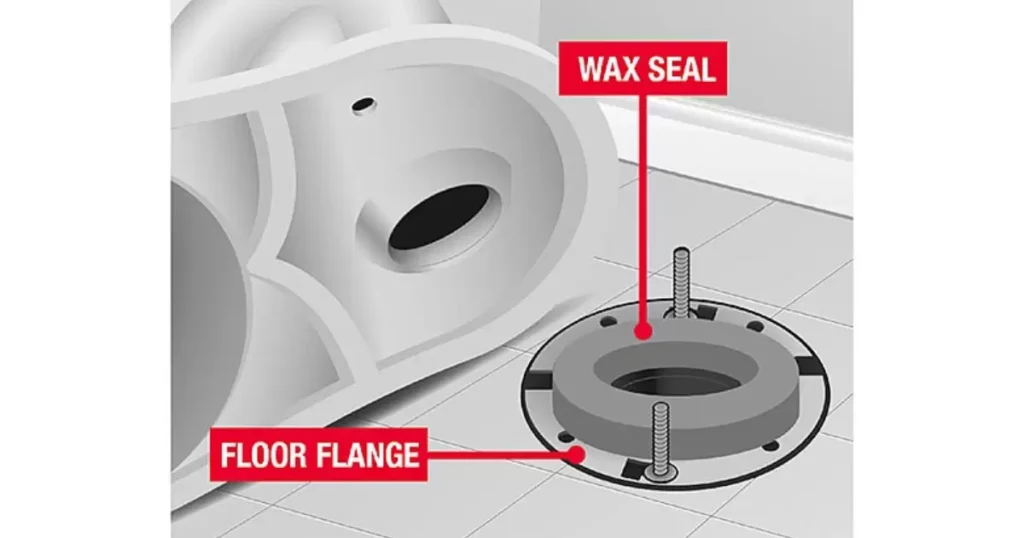
Lowering the toilet flange is necessary when installing vinyl plank flooring to ensure a proper fit for the toilet. To lower the flange remove the toilet and adjust the flange height using a hacksaw or specialized tool as needed.
This ensures that the toilet sits flush with the new flooring once installed.Adding underlayment is another important step in preparing for vinyl plank flooring installation. The underlayment provides additional cushioning sound absorption and moisture protection for the vinyl planks.
Simply lay the underlayment over the subfloor before installing the vinyl planks to enhance comfort and performance.
Lower Toilet Flange
Lowering the toilet flange is a crucial step when installing new flooring like vinyl planks in a bathroom. Begin by turning off the water supply to the toilet and removing it from the flange. Next use a hacksaw or specialized tool to trim the flange down to the desired height ensuring it sits flush with the new flooring.
Lowering the toilet flange ensures a proper fit for the toilet once the new flooring is installed preventing any gaps or unevenness that could lead to leaks or instability. Take care to follow manufacturer instructions and local plumbing codes when making adjustments to the toilet flange for a safe and effective installation.
Add Silicone Caulk Along Bathtub
Silicone caulk along the bathtub is a crucial step to prevent water damage and ensure a watertight seal. Begin by thoroughly cleaning the area around the bathtub to remove any dirt debris or old caulk.
Apply a bead of silicone caulk along the joint where the bathtub meets the wall using a caulk gun for precision. Smooth the caulk with a wet finger or caulk tool to create a neat and uniform seal that helps protect against leaks and moisture infiltration.
Add Plywood to Subfloor
Adding plywood to the subfloor is a common practice to create a smooth and stable surface for installing vinyl plank flooring. Begin by measuring and cutting the plywood to fit the dimensions of the room, ensuring it covers the entire subfloor area.
Next, lay the plywood sheets over the subfloor staggering the seams and leaving a small gap between each sheet for expansion. Finally secure the plywood to the subfloor using screws or nails ensuring it is firmly attached and level before proceeding with the vinyl plank installation.
Add More Silicone Caulk In Front of Bathtub
Adding more silicone caulk in front of the bathtub is essential to maintain a watertight seal and prevent water damage. Begin by thoroughly removing any old or damaged caulk using a caulk remover tool or utility knife.
Clean the area with a mild detergent and allow it to dry completely before proceeding.Once the area is clean and dry apply a new bead of silicone caulk along the joint where the bathtub meets the floor using a caulk gun for precision.
Ensure the caulk is applied evenly and smoothly and use a wet finger or caulk tool to smooth it out and create a neat finish. This additional layer of silicone caulk helps reinforce the seal and provides added protection against water leaks and moisture infiltration.
Layout and Install First Row of Tiles
To layout and install the first row of tiles, start by measuring the width of the room and determining the center point. Use a chalk line or straightedge to mark a straight line across the floor at this center point as a guide for the first row.
Begin laying the tiles along this line starting from one end of the room and working your way to the other ensuring they are evenly spaced and aligned.Once the first row is laid out double check that it is straight and square before proceeding with installation.
Use tile spacers to maintain consistent spacing between tiles and a tile cutter or wet saw to cut tiles as needed to fit around obstacles or along edges. Take your time to ensure the first row is installed correctly as it sets the foundation for the rest of the tile installation.
Plan Your Layout
Planning your layout is a crucial step before beginning any flooring installation project. Start by measuring the dimensions of the room and considering any obstacles such as cabinets or fixtures.
Determine the direction in which you want the flooring planks to run parallel or perpendicular to the longest wall to achieve the desired aesthetic.Next lay out a test row of vinyl planks without securing them to the floor to visualize how the pattern will look and ensure a balanced layout.
Consider factors such as planck length width and pattern variation to achieve a harmonious appearance. Make any necessary adjustments to ensure the layout is symmetrical and pleasing to the eye before proceeding with installation. Taking the time to plan your layout carefully helps ensure a professional looking finish and minimizes wasted materials.
Adjust Tiles to Straight Reference Line
To adjust tiles to a straight reference line start by placing the first tile along the line ensuring it is perfectly aligned. Use a level or straightedge to check for any deviations from the line and make adjustments as needed.
Continue laying tiles along the line periodically checking for straightness and making any necessary corrections to maintain alignment. Taking the time to ensure tiles are aligned with the reference line results in a professional looking installation.
Drill Holes For Water Lines and Toilet Flange
To drill holes for water lines and the toilet flange mark the positions of the holes on the subfloor using a pencil or marker. Use a drill with an appropriate sized bit to carefully drill holes at the marked locations ensuring they are aligned correctly.
Take care not to drill too deeply or at an angle to prevent damage to the subfloor or pipes. Once the holes are drilled you can proceed with installing the water lines and securing the toilet flange in place for a secure and functional installation.
Install and Tap Flooring Into Place
To install and tap flooring into place begin by starting in one corner of the room. Place the first plank against the wall ensuring it is snugly fitted.
Use a tapping block and rubber mallet to gently tap the next plank into place ensuring a tight seam between planks.
Continue this process working row by row until the entire floor is covered tapping each plank firmly into place for a secure installation.
Install Vinyl Plank Flooring Around Toilet Flange
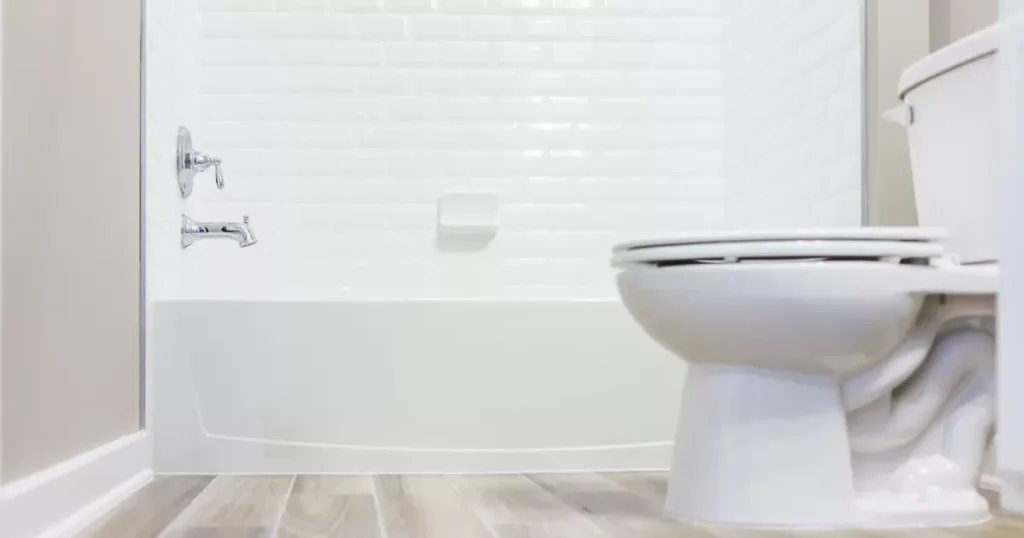
When installing vinyl plank flooring around a toilet flange start by cutting the planks to fit around the flange leaving a small gap for expansion. Carefully measure and mark the cuts using a pencil or marker ensuring accuracy for a precise fit.
Once the planks are cut carefully lay them around the toilet flange making sure they fit snugly against the flange without covering it. Use a utility knife or jigsaw to make any necessary adjustments to ensure the planks fit securely around the flange.
Taking care during this step ensures a professional-looking finish and allows for easy installation of the toilet once the flooring is complete.
Tap 2nd Row of Flooring Into Place
To tap the second row of flooring into place, begin by inserting the tongue of the second row into the groove of the first row at a slight angle. Use a tapping block and rubber mallet to gently tap the second row into place, ensuring a snug fit against the first row.
Continue tapping each plank of the second row into place, working from one end of the row to the other. Ensure that each plank is securely locked into position before moving on to the next, maintaining a tight seam between planks for a professional-looking finish.
Install Last Row of Vinyl Plank Flooring
To install the last row of vinyl plank flooring measure and cut the planks to fit the remaining space leaving a small gap for expansion against the wall. Ensure the planks are cut to the appropriate width, accounting for any irregularities in the wall.
Carefully place each plank into position ensuring they fit snugly against the previous row and the wall. Use a tapping block and rubber mallet to gently tap the last row into place ensuring a secure and seamless finish.
Frequently Asked Questions
Which way do you lay vinyl planks in a bathroom?
It is typically recommended to lay vinyl planks parallel to the longest wall to create a visually pleasing and spacious appearance. This orientation helps to elongate the space and maintain a cohesive look throughout the room.
Can I use vinyl flooring in a bathroom?
Yes, you can use vinyl flooring in a bathroom. Vinyl flooring is waterproof and durable, making it an excellent choice for bathrooms where moisture and humidity are present.
What do you put under vinyl plank flooring in a bathroom?
Under vinyl plank flooring in a bathroom, you can use an underlayment for added cushioning and moisture protection. This helps to create a stable and comfortable surface while providing extra insulation against moisture and sound.
Should vinyl flooring go before or after bathroom fixtures?
Vinyl flooring should go before bathroom fixtures are installed. This allows for easier installation and ensures a seamless look with the flooring extending under fixtures like toilets and vanities.
Can vinyl flooring be used in a shower?
No, vinyl flooring is not suitable for use in a shower. Vinyl is not designed to withstand constant exposure to water and moisture like ceramic or porcelain tiles, which are more suitable options for shower areas.
Conclusion
Vinyl plank flooring offers a versatile and practical solution for bathroom renovations. Its waterproof nature durability and ease of installation make it an ideal choice for bathrooms where moisture and humidity are common.
By following proper installation techniques and considering factors such as subfloor preparation and layout planning homeowners can achieve a professional looking result that enhances the functionality and aesthetic appeal of their bathroom spaces.
Overall vinyl plank flooring provides a cost effective and stylish flooring option that meets the unique needs of bathroom environments.
